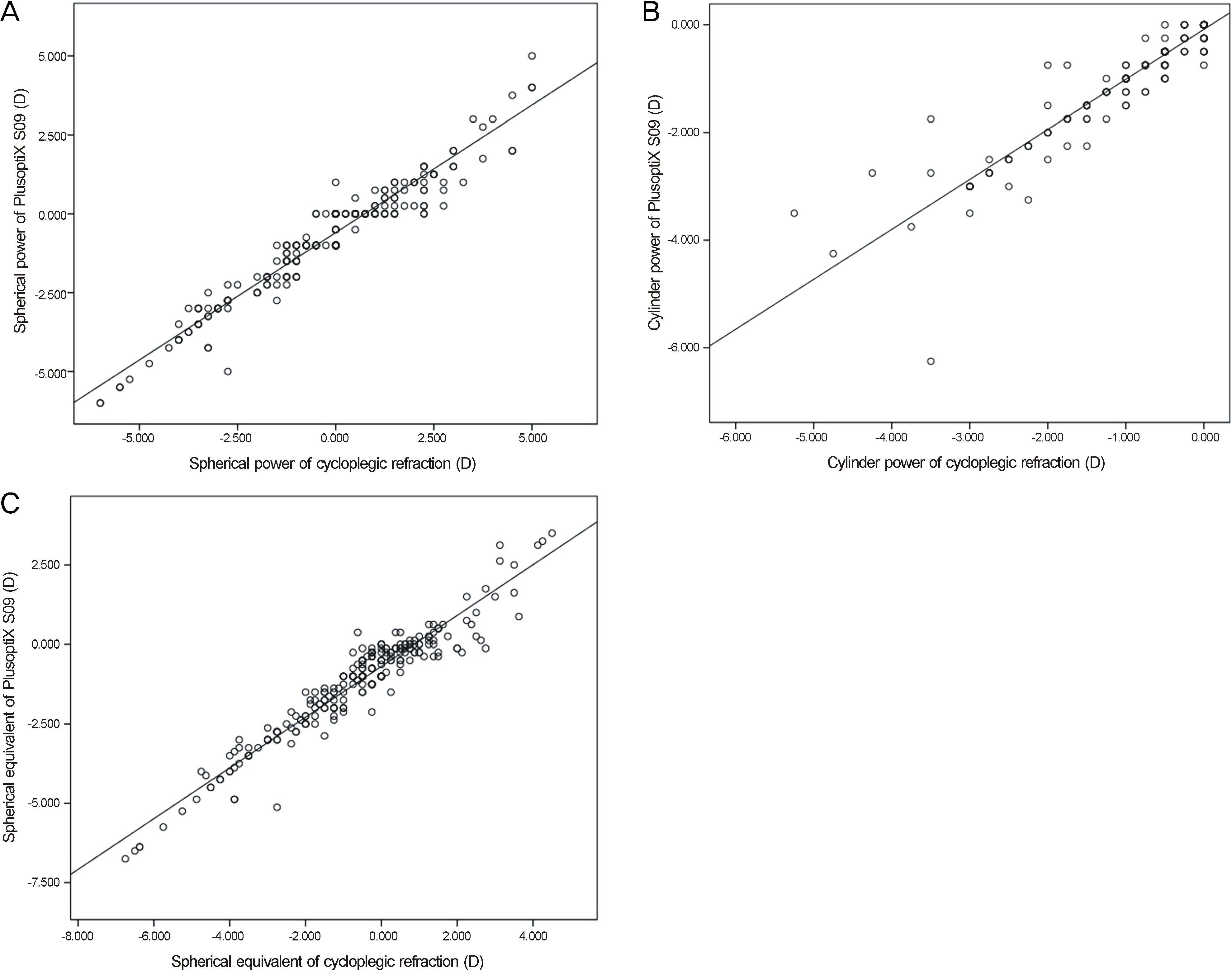J Korean Ophthalmol Soc.
2014 Jul;55(7):1071-1076.
Reliability and Usefulness of Refractive Measurements by PlusoptiX S09 in Children
- Affiliations
-
- 1Department of Ophthalmology, Sahmyook Medical Center, Seoul, Korea. ymedi@hanmail.net
Abstract
- PURPOSE
To compare the refractive measurements obtained using a photorefractor (PlusoptiX S09, PlusoptiX GmbH, Germany) with those obtained using cycloplegic refraction in children.
METHODS
We assessed the refractive status of 268 eyes in 134 children. The values acquired via photorefraction with a PlusoptiX S09 device were compared with those obtained by cycloplegic retinoscopy. Hyperopia (> or =+3.5 D), myopia (> or =-3.0 D), with the rule or against the rule astigmatism (> or =-1.5 D), and oblique astigmatism (> or =-1.0 D) were set as diagnostic criteria for refractive amblyopia risk factors (RARFs). The difference in the detection of RARFs by the two methods was the main outcome measure.
RESULTS
The average spherical refractive power was -0.81 +/- 1.68 D for PlusoptiX S09 versus -0.26 +/- 2.00 D for cycloplegic retinoscopy (average difference -0.54 +/- 0.61 D; p < 0.001). The average spherical equivalent was -1.20 +/- 1.62 D for PlusoptiX S09 versus -0.64 +/- 1.94 D for cycloplegic retinoscopy (average difference -0.56 +/- 0.62 D; p < 0.001). The average cylinder power was -0.79 +/- 0.93 D for PlusoptiX S09 versus -0.76 +/- 0.94 D for cycloplegic retinoscopy (average difference -0.03 +/- 0.33 D; p = 0.135). Even though cycloplegic retinoscopy is considered the gold standard, the sensitivity and specificity for detecting RARFs with the PlusoptiX S09 were 88.0% and 96.3%, respectively.
CONCLUSIONS
PlusoptiX S09 is a relatively useful method for detecting RARFs, but the device tends toward myopic shift compared to cycloplegic refraction, and hyperopia is underestimated.
Keyword
MeSH Terms
Figure
Reference
-
References
1. Parks MM. The monofixation syndrome. Trans Am Ophthalmol Soc. 1969; 67:609–57.2. Schimitzek T, Haase W. Efficiency of a video-autorefractometer used as a screening device for amblyogenic factors. Graefe's Arch Clin Exp Ophthalmol. 2002; 240:710–6.
Article3. Miller JM, Dobson V, Harvey EM, Sherrill DL. Cost-efficient vision screening for astigmatism in native american preschool children. Invest Ophthamol Vis sci. 2003; 44:3756–63.
Article4. Moon NJ, Kim JC, Koo BS. The study on the necessity of cycloplegic refraction in school children. J Korean Ophthalmol Soc. 1988; 29:377–85.5. La TY, Oh JR. Reliability of refractive measurement by hand-held autorefractor. J Korean Ophthalmol Soc. 2002; 43:2241–5.6. Cho CW, Kim SJ, Park YG. The utility of hand held autorefrac- tometer for refraction in children. J Korean Ophthalmol Soc. 1997; 38:1044–9.7. Donahue SP, Arnold RW, Ruben JB. Preschool vision screening: What should we be detecting and how should we report it? Uniform guidelines for reporting results of preschool vision screening studies. J AAPOS. 2003; 7:314–6.
Article8. Perrigin DM, Perrigin J, Grosvenor T. A clinical evalusation of the American Optical SR III subjective refractor. Am J Optom Physiol Opt. 1981; 58:581–9.9. Paff T, Marie A, Wolterbeek R, et al. Screening for refractive errors in children: The plusoptiX S08 and the Retinomax K-plus2 performed by a lay screener compared to cycloplegic retinoscopy. J AAPOS. 2010; 14:478–83.
Article10. Schimitzek T, Lagréze WA. Accuracy of a new photorefractometer in young and adult patients. Graefe's Arch Clin Exp Ophthalmol. 2005; 243:637–45.
Article11. Erdurmus M, Yagci R, Karadag R, Durmus M. A comparison of photorefraction and retinoscopy in children. J AAPOS. 2007; 11:606–11.
Article12. Kiyak Y, Onder U, Suheyla K. Accuracy of plusoptix S04 in children and teens. Can J Ophthalmol. 2011; 46:153–7.13. Kim MS, Chang HR. The evaluation of noncycloplegic and cycloplegic autorefraction in children according to the age. J Korean Ophthalmol Soc. 1998; 39:106–12.14. Bobier WR, Braddick OJ. Eccentric photorefraction: optical analysis and empirical measures. Am J Optom Physiol Opt. 1985; 62:614–20.15. Howland HC. Optics of photoretinoscopy: results from ray tracing. Am J Optom Physiol Opt. 1985; 62:621–5.16. Bobier WR, Campbell MCW, McCreary CR, et al. Geometrical optical analysis of photorefractive methods. Ophthal Physiol Opt. 1992; 12:147–52.
Article17. Rajavi Z, Parsafar H, Ramezani A, Yaseri M. Is noncycloplegic photorefraction applicable for screening refractive amblyopia risk factors. J Ophthalmic Vis Res. 2012; 7:3–9.


